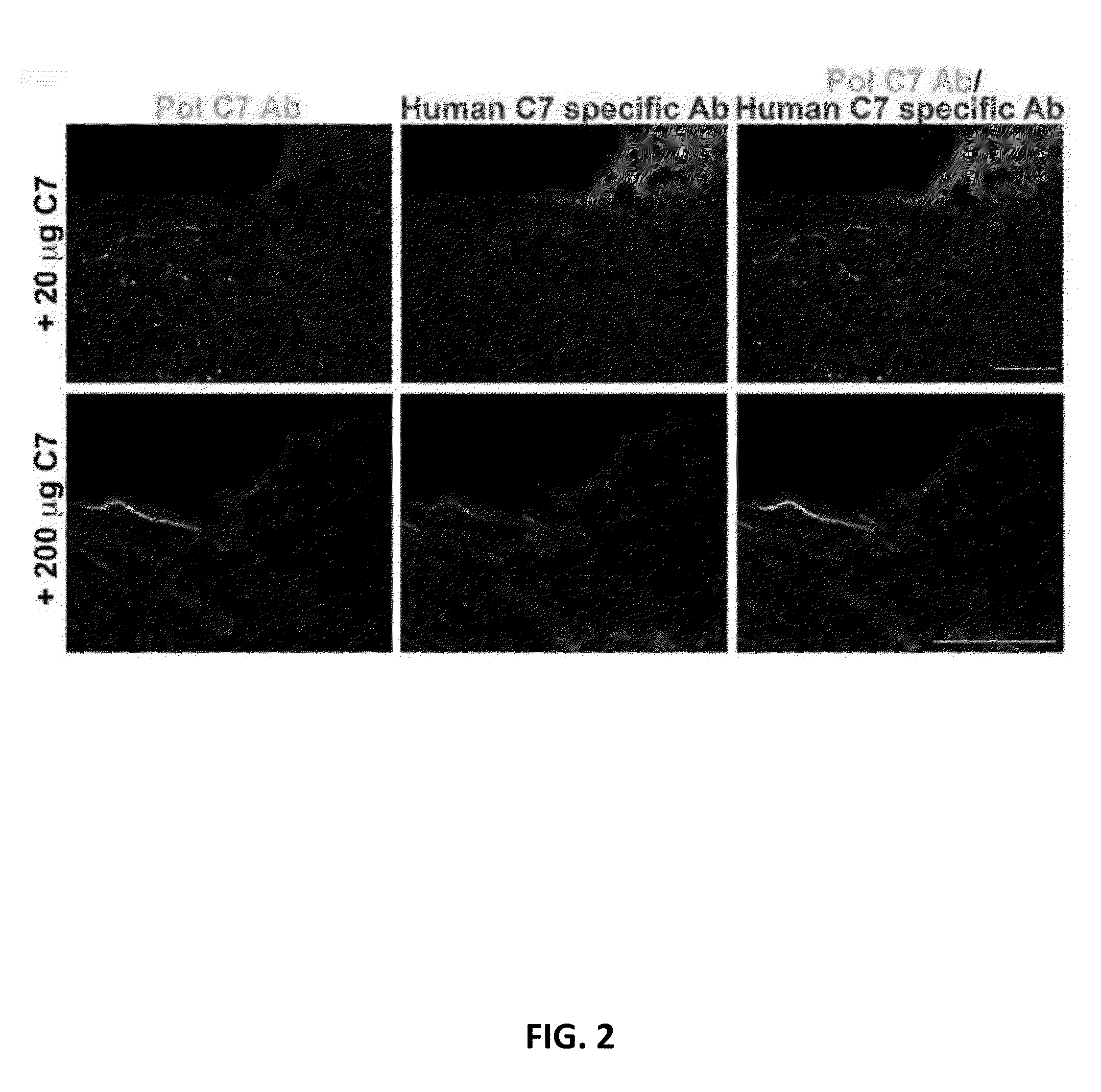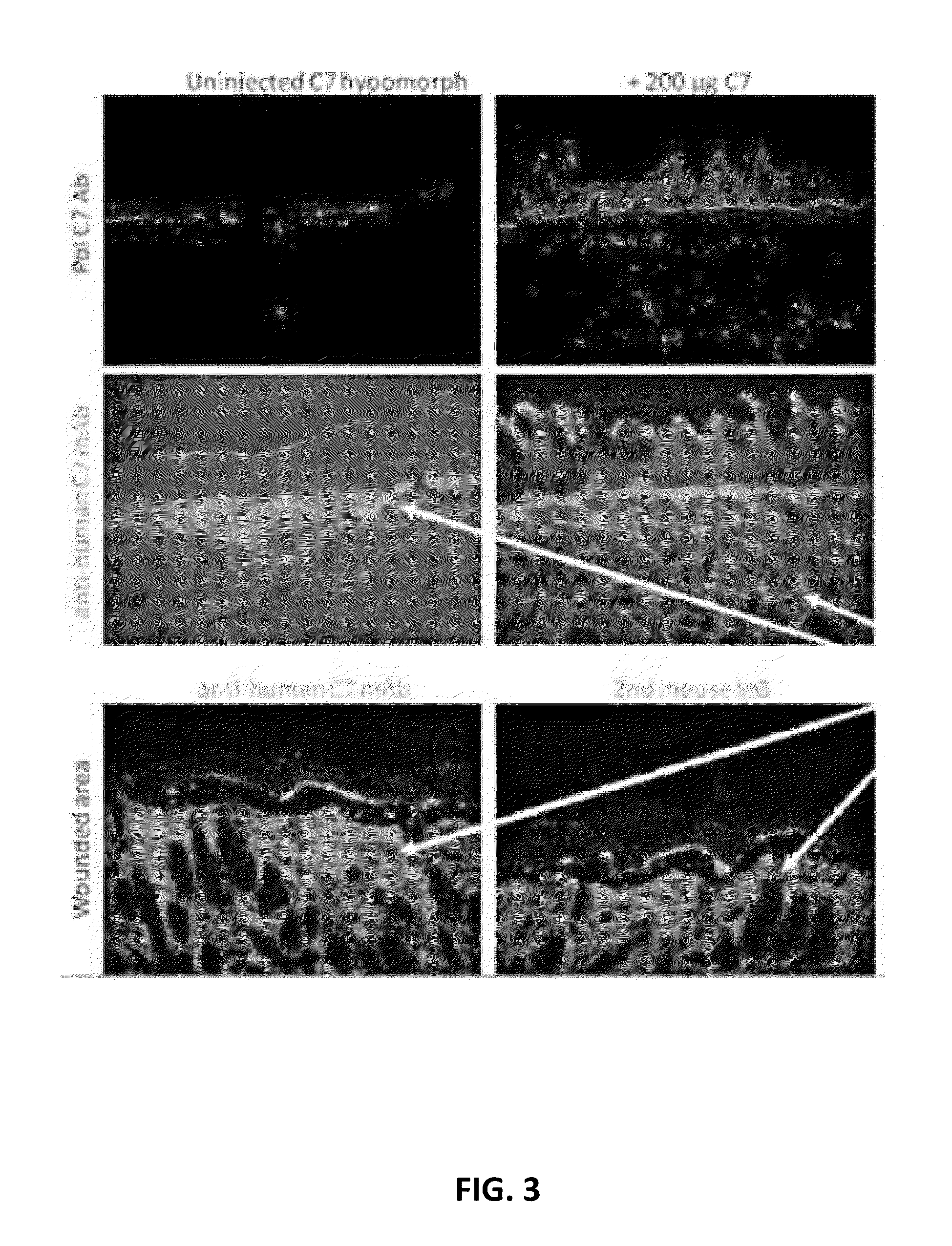Recombinant C7 and Methods of Use
a technology of recombinant c7 and c7, which is applied in the field of recombinant c7, can solve the problems of severe blistering and skin erosion, vision loss, disfigurement, other serious medical problems, and rdeb, and achieve the effect of preventing the progression of one or more symptom or delaying the onset of one or more symptom
- Summary
- Abstract
- Description
- Claims
- Application Information
AI Technical Summary
Benefits of technology
Problems solved by technology
Method used
Image
Examples
example 1
RDEB Mouse Model of IV Administration of Collagen 7
[0097]RDEB (C7 hypomorphic) mice show a similar clinical phenotype to human DEB patients, including blistering, forepaw pseudosyndactyly, growth retardation, and rectal blistering. As occurs in human DEB, hypomorphic RDEB mice have been shown to express collagen 7 at about 10% of normal level at the basement membrane zone of the skin and display separation of the dermis and epidermis in the skin compared. In addition, the phenotypes of these mice closely mimic characteristics of severe human RDEB, including mucocutaneous blistering, nail dystrophy, and mitten deformities of the extremities. Thus, the RDEB mouse model provides an excellent animal model for the study of DEB.
[0098]In order to establish the use of the RDEB mouse model for IV administration of collagen 7, two RDEB mice with full thickness skin wounds were dosed with 20 μg or 200 μg of collagen 7 via tail vein IV injection. Accordingly, mice were given either a single IV ...
example 2
Chronic Collagen 7 Administration Prevents, Reduces, and Delays RDEB Associated Complications in RDEB Mice
[0100]In order to evaluate the effect of chronic collagen 7 administration on the RDEB phenotype, three RDEB mice were injected with 200 μg of collagen 7 every other week for 12 weeks or until demise. Three PBS-treated RDEB mice were used as controls. Collagen 7 was mainly administered via IV tail vein injections. In some cases collagen 7 was injected retro-orbitally when tail vein injections were difficult to perform. During weekly evaluation the mice were weighed and photographed, along with examination of their paws, skin, and rectum. At the end of the 12 week period the skin and other organs were analyzed for collagen 7 expression.
[0101]Immunofluorescence analysis demonstrated chronic administration of collagen 7 resulted in the deposition of human collagen 7 in the skin, tongue, and esophagus (FIG. 4). Moreover, chronic collagen 7 administration delayed forepaw pseudosyndac...
example 3
IV Administered Recombinant Collagen 7 Homes Selectively to Wounded and Unwounded DEB Skin Grafted onto Athymic Nude Mice
[0103]In order to evaluate the homing and deposition of recombinant collagen 7 administered intravenously, an DEB skin grafted onto athymic nude mouse model, in which the mice possess skin grafts obtained from collagen 7 knock out RDEB mice were utilized (FIG. 9). In brief, skin from collagen 7 knockout RDEB mice that completely lack collagen C7 expression at the basement membrane zone was grafted onto athymic nude mice. After two weeks, the RDEB skin was wounded using 6 mm punch biopsies or left unwounded and recombinant collagen 7 was administered IV via tail vein injection. The mice were sacrificed at two to three weeks post collagen 7 administration, and skin biopsies from the grafted DEB skin were analyzed by hematoxylin and eosin stain, immunofluorescence, or electron microscopy. Biopsies from various other organs from the host athymic nude mice were taken ...
PUM
| Property | Measurement | Unit |
|---|---|---|
| time | aaaaa | aaaaa |
| time | aaaaa | aaaaa |
| time | aaaaa | aaaaa |
Abstract
Description
Claims
Application Information
 Login to View More
Login to View More - Generate Ideas
- Intellectual Property
- Life Sciences
- Materials
- Tech Scout
- Unparalleled Data Quality
- Higher Quality Content
- 60% Fewer Hallucinations
Browse by: Latest US Patents, China's latest patents, Technical Efficacy Thesaurus, Application Domain, Technology Topic, Popular Technical Reports.
© 2025 PatSnap. All rights reserved.Legal|Privacy policy|Modern Slavery Act Transparency Statement|Sitemap|About US| Contact US: help@patsnap.com



